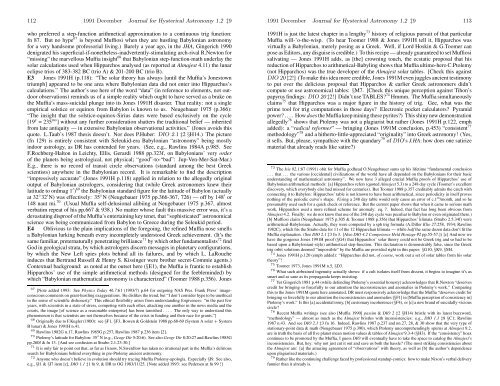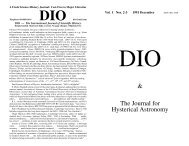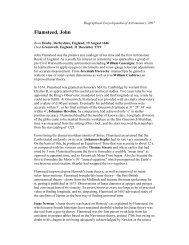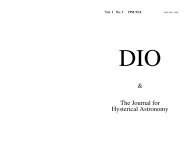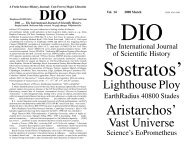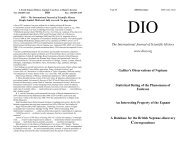DIO 1.2 - DIO, The International Journal of Scientific History
DIO 1.2 - DIO, The International Journal of Scientific History
DIO 1.2 - DIO, The International Journal of Scientific History
You also want an ePaper? Increase the reach of your titles
YUMPU automatically turns print PDFs into web optimized ePapers that Google loves.
112 1991 December <strong>Journal</strong> for Hysterical Astronomy <strong>1.2</strong> ‡9<br />
who preferred a step-function arithmetical approximation to a continuous trig function:<br />
fn 87. But no hype 67 is beyond Muffiosi when they are hustling Babylonian astronomy<br />
for a very handsome pr<strong>of</strong>essorial living.) Barely a year ago, in the JHA, Gingerich 1990<br />
denigrated his superficial-if-nonetheless-inadvertently-stimulating arch-rival R.Newton for<br />
“missing” the marvellous Muffia insight 68 that Babylonian step-function-math underlay the<br />
solar calculations used when Hipparchos analysed (as reported at Almajest 4.11) the lunar<br />
eclipse trios <strong>of</strong> 383-382 BC (trio A) & 201-200 BC (trio B).<br />
E3 Jones 1991H (p.118): “<strong>The</strong> solar theory has always [until the Muffia’s Jonestown<br />
triumph] appeared to be one area where Babylonian data did not enter into Hipparchus’s<br />
calculations.” <strong>The</strong> author’s use here <strong>of</strong> the word “data” (in reference to elements, not outdoor<br />
observations) reminds us <strong>of</strong> a simple reality which ought to have served as a brake on<br />
the Muffia’s mass-suicidal plunge into its Jones 1991H disaster. That reality: not a single<br />
empirical solstice or equinox from Babylon is known to us. Neugebauer 1975 (p.366):<br />
“<strong>The</strong> insight that the solstice-equinox-Sirius dates were based exclusively on the cycle<br />
[19 y = 235 mo ] without any further consideration shatters the traditional belief — inherited<br />
from late antiquity — in extensive Babylonian observational activities.” (Jones avoids this<br />
quote. L.Taub’s 1987 thesis doesn’t. Nor does P.Huber: <strong>DIO</strong> 2.1 ‡2 §H14.) <strong>The</strong> picture<br />
(fn 129) is entirely consistent with Seleukid-era Babylonian “astronomy” being mostly<br />
indoor astrology, as DR has contended for years. (See, e.g., Rawlins 1984A p.985. See<br />
F.Rochberg-Halton in Leichty, Ellis, Gerardi 1988 pp.323f, on Babylonians’ very order<br />
<strong>of</strong> the planets being astrological, not physical; “good”-to-“bad”: Jup-Ven-Mer-Sat-Mar.)<br />
E.g., there is no record <strong>of</strong> transit circle observations (standard among the best Greek<br />
scientists) anywhere in the Babylonian record. It is remarkable to find the description<br />
“impressively accurate” (Jones 1991H p.118) applied in relation to the allegedly original<br />
output <strong>of</strong> Babylonian astrologers, considering that (while Greek astronomers knew their<br />
latitude to ordmag 1 ′ ) 69 the Babylonian standard figure for the latitude <strong>of</strong> Babylon (actually<br />
at 32 ◦ 32 ′ N) was effectively: 35 ◦ N (Neugebauer 1975 pp.366-367, 726) — <strong>of</strong>f by 148 ′ or<br />
148 naut mi. 70 (Usual Muffia self-delusional alibiing at Neugebauer 1975 p.367, almost<br />
verbatim repeat <strong>of</strong> his pp.667 & 938.) No matter whose fault this massive error was, it’s a<br />
devastating dispro<strong>of</strong> <strong>of</strong> the Muffia’s entertaining key tenet, that “sophisticated” astronomical<br />
science was being communicated from Babylon to Greece during the Seleukid period.<br />
E4 Oblivious to the plain implications <strong>of</strong> the foregoing, the refined Muffia nose smells<br />
a Babylonian lurking beneath every incompletely understood Greek achievement. (It’s the<br />
same familiar, preternaturally penetrating brilliance 71 by which other fundamentalists 72 find<br />
God in geological strata, by which astrologers discern messages in planetary configurations,<br />
by which the New Left spies plots behind all its failures, and by which L. LaRouche<br />
induces that Bertrand Russell & Henry S. Kissinger were brother secret-Commie agents.)<br />
Contextual background: as noted at the outset here (§E1), the Muffia is frantic to establish<br />
Hipparchos’ use <strong>of</strong> the simple arithmetical methods (designed for the feebleminded) by<br />
which “Babylonian mathematical astronomy is characterized” (Toomer 1988 p.356). Jones<br />
67 [Note added 1993: See Physics Today 46.7:61 (1993/7) p.64 for outgoing NAS Pres. Frank Press’ imageconscious<br />
comments on grant-hustling exaggerations. He dislikes the trend, but “I don’t consider hype to be unethical<br />
in the sense <strong>of</strong> scientific dishonesty.” This ethical flexibility arises from understanding forgiveness: “in the past few<br />
years, with scientists in a state <strong>of</strong> stress, competing with each other, attacking one another in the news media and the<br />
courts, the image [<strong>of</strong> science as a reasonable enterprise] has been tarnished . . . . <strong>The</strong> only way to understand this<br />
phenomenon is that scientists are not themselves because <strong>of</strong> the crisis in funding and their race for grants.”]<br />
68 Originally due to F.Kugler (1900): see §F1, §F3, Bowen & Goldstein 1988 pp.68-69 (System A solar + System<br />
B lunar) & Jones 1991H n.41.<br />
69 Rawlins 1982G n.17, Rawlins 1985G p.257, Rawlins 1987 p.236 item [2].<br />
70 Ptolemy’s latitude for Babylon: 35 ◦ N (e.g., Geogr Dir 5:20:6). See also Geogr Dir 8:20:27 and Rawlins 1985G<br />
pp.260f & fn 13. [And see confusion at Strabo 2.<strong>1.2</strong>3-30.]<br />
71 It is only fair to point out that, as far as I know, N.Swerdlow has taken no irrational part in the Muffia’s delirious<br />
search for Babylonians behind everything in pre-Ptolemy ancient astronomy.<br />
72 Anyone who doesn’t believe in evolution should try tracing Muffia Ptolemy-apologia. Especially §I9. See also,<br />
e.g., §I1 & §I7 item [c], <strong>DIO</strong> 1.1 ‡1 fn 9, & DR to OG 1983/11/25. [Note added 1993: see Pedersen at fn 99 !]<br />
1991 December <strong>Journal</strong> for Hysterical Astronomy <strong>1.2</strong> ‡9 113<br />
1991H is just the latest chapter in a lengthy 73 history <strong>of</strong> religious pursuit <strong>of</strong> that particular<br />
Muffia will-’o-the-wisp. (To hear Toomer 1988 & Jones 1991H tell it, Hipparchos was<br />
virtually a Babylonian, merely posing as a Greek. Well, if Lord Hoskin & G.Toomer can<br />
pose as Editors, any disguise is credible.) To this recipe — already guaranteed to set Muffiosi<br />
salivating — Jones 1991H adds, as [the] crowning touch, the ecstatic proposal that his<br />
reduction <strong>of</strong> Hipparchos to arithmetical-Babyling shows that Muffia ultimo-hero C.Ptolemy<br />
(not Hipparchos) was the true developer <strong>of</strong> the Almajest solar tables. [Check this against<br />
<strong>DIO</strong> 20 ‡2!] (To make this idea more credible, Jones 1991M even juggles ancient testimony<br />
to put over the delicious proposal that Hipparchos & earlier Greek astronomers didn’t<br />
compute or use astronomical tables: §M7. [Check this unique perception against Tihon’s<br />
papyrus findings: <strong>DIO</strong> 20 ‡2!] Didn’t use TABLES? 74 Hmmm. <strong>The</strong> Muffia simultaneously<br />
claims 75 that Hipparchos was a major figure in the history <strong>of</strong> trig. Gee, what was the<br />
prime tool for trig computations in those days? Electronic pocket calculators? Pyramid<br />
power? . . . . How does the Muffia keep mining these pyrites?) This shiny new demonstration<br />
allegedly 76 shows that Ptolemy was not a plagiarist but rather (Jones 1991H p.122, emph<br />
added): a “radical reformer” — bringing (Jones 1991M conclusion, p.453) “consistent 77<br />
methodology” 78 and a hitherto-little-appreciated “originality” into Greek astronomy! (Yes,<br />
it sells. But, please, sympathize with the quandary 79 <strong>of</strong> <strong>DIO</strong>’s J.HA: how does one satirize<br />
material that already reads like satire?)<br />
73 <strong>The</strong> Isis 82.1:87 (1991) obit for Muffia godhead O.Neugebauer sums up his lifetime “fundamental conclusion<br />
. . . that . . . the various [occidental] civilizations <strong>of</strong> the world have all depended on the Babylonians for their basic<br />
understanding <strong>of</strong> mathematical astronomy”. We now have 3 alleged crucial Muffia pro<strong>of</strong>s <strong>of</strong> Hipparchos’ use <strong>of</strong><br />
Babylonian arithmetical methods: [a] Hipparchos refers (quoted Almajest 5.3) to a 248 day cycle (Toomer’s excellent<br />
discovery, which everybody else had missed for centuries). But Toomer 1988 p.357 creditably admits the catch with<br />
connecting it to Babylon: Hipparchos’ table is not known to have been arithmetical, since periodicity in itself proves<br />
nothing <strong>of</strong> the periodic curve’s shape. (Using a 248 day table would only cause an error <strong>of</strong> c.1 m /month, and so he<br />
presumably used such for a quick check or reference. But the current paper shows that when it came to serious math<br />
work, Hipparchos used a more refined scheme for anomaly: eq. 7. Indeed, that fact has long been obvious from<br />
Almajest 4.2. Finally: we do not know that use <strong>of</strong> the 248 day cycle was peculiar to Babylon or even originated there.)<br />
[b] Muffiosi claim (Neugebauer 1975 p.305 & Toomer 1988 p.356) that Hipparchos’ klimata (Strabo 2.5.34f) were<br />
arithmetical-Babylonian. Actually, they were computed by a sph trig formula (A.Diller Klio 27:258, 1934; Rawlins<br />
1982C), which fits the Strabo data for 11 <strong>of</strong> the 12 Hipparchan klimata — while half the same dozen data don’t fit the<br />
Muffia explanation. (See <strong>DIO</strong> 2.1 ‡3 fn 3. [Also <strong>DIO</strong> 4.2 Competence Held Hostage #2 pp.55-57.]) [c] And now we<br />
have the gorgeous Jones 1991H pro<strong>of</strong> (§G4) that Hipparchos’ solar theory could not be Greek trig and so had to be<br />
based upon a Babylonian(-style) arithmetical step-function. This declaration is demonstrably false, since the Greek<br />
trig orbit solutions deemed “impossible” by the Muffia are provided right in this paper: §G10, §K9, §M4.<br />
74 Jones 1991H p.120 (emph added): “Hipparchus did not, <strong>of</strong> course, work out a set <strong>of</strong> solar tables from his solar<br />
theory”!<br />
75 Toomer 1973, Jones 1991M n.5, §D3.<br />
76 What such airbrained ingenuity actually shows: if a cult isolates itself from dissent, it begins to imagine it’s as<br />
smart and as sane as its propaganda keeps insisting.<br />
77 Yet Gingerich 1981 p.44 (while defending Ptolemy’s essential honesty) acknowledges that R.Newton “deserves<br />
credit for bringing so forcefully to our attention the inconsistencies and anomalies in Ptolemy’s work.” Comparing<br />
this to the Jones 1991M quote here annotated, DR must responsively acknowledge that the Muffia “deserves credit for<br />
bringing so forcefully to our attention the inconsistencies and anomalies [§F1] in [Muffia perception <strong>of</strong> consistency in]<br />
Ptolemy’s work.” Is this [a] accidental irony, [b] customary incoherence (§F4), or [c] a new brand <strong>of</strong> suicidally-vicious<br />
circle?<br />
78 Recent Muffia writings (see also [Muffia 1990] passim & <strong>DIO</strong> 2 ‡2 §H14) bristle with its latest buzzword,<br />
“methodology” — almost as much as the Almajest bristles with inconsistencies: e.g., <strong>DIO</strong> 1.1 ‡8 §C1; Rawlins<br />
1987 n.43. And see <strong>DIO</strong> 2.1 ‡3 fn 16. Indeed, Rawlins 1987 p.237 and nn.27, 28, & 30 show that the very type <strong>of</strong><br />
stationary-point data & math (Neugebauer 1975 p.390), which Ptolemy uncomprehendingly spurns at Almajest 9.2,<br />
are in truth the basis <strong>of</strong> all five planet mean motion values & tables <strong>of</strong> Almajest 9.3-4 (§H3). If the “consistency” hoax<br />
continues to be promoted by the Muffia, I guess <strong>DIO</strong> will eventually have to take the space to catalog the Almajest’s<br />
inconsistencies. But, hey: why not just cut it out and save us both the hassle? (<strong>The</strong> most striking consistencies about<br />
the Almajest are: [a] the amazing agreement <strong>of</strong> “observations” with theory, as well as [b] the author’s dependence<br />
upon plagiarized materials.)<br />
79 Rather like the continuing challenge faced by pr<strong>of</strong>essional standup-comics: how to make Nixon’s verbal delivery<br />
funnier than it already is.


